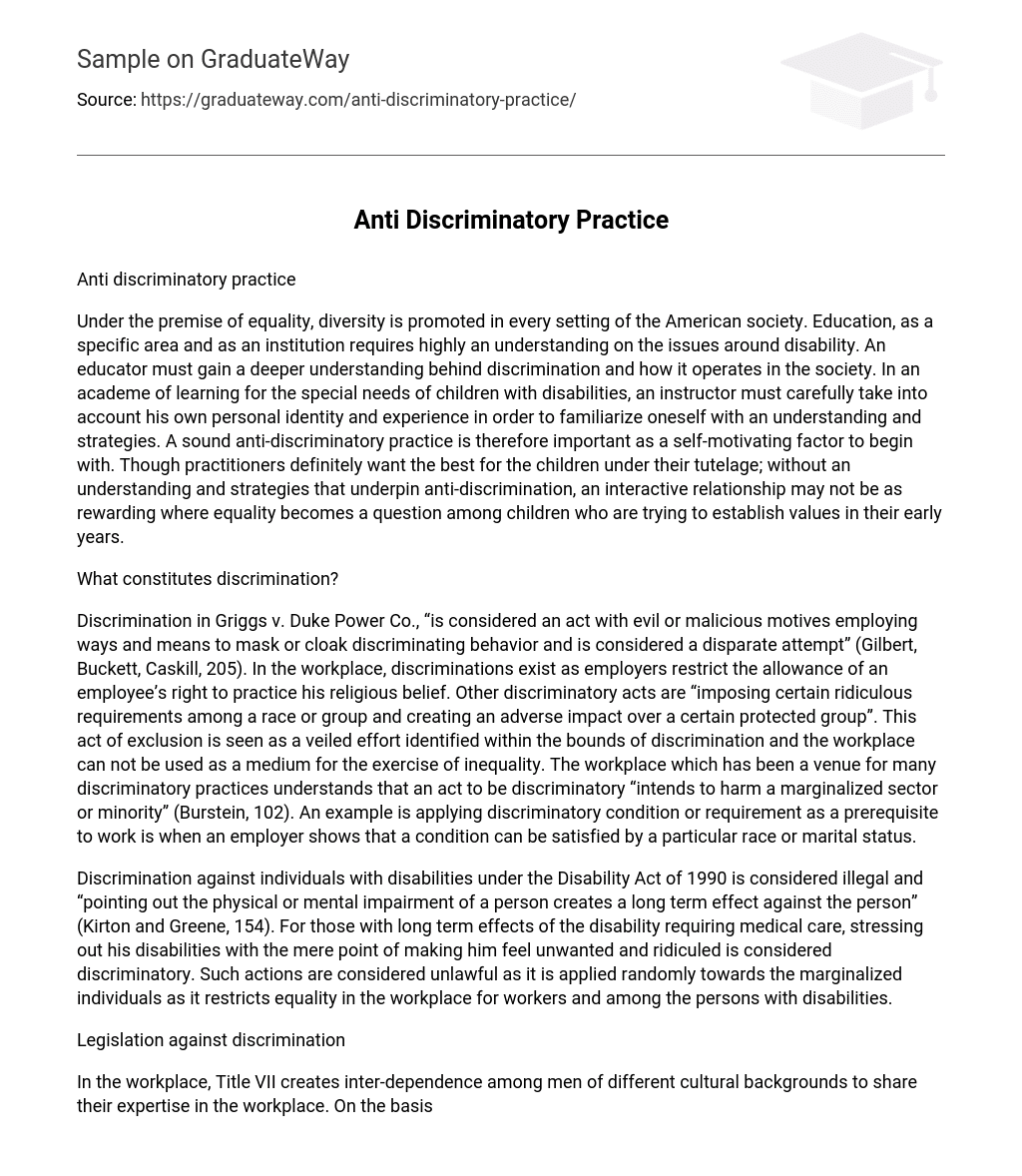Under the premise of equality, diversity is promoted in every setting of the American society. Education, as a specific area and as an institution requires highly an understanding on the issues around disability. An educator must gain a deeper understanding behind discrimination and how it operates in the society. In an academe of learning for the special needs of children with disabilities, an instructor must carefully take into account his own personal identity and experience in order to familiarize oneself with an understanding and strategies. A sound anti-discriminatory practice is therefore important as a self-motivating factor to begin with. Though practitioners definitely want the best for the children under their tutelage; without an understanding and strategies that underpin anti-discrimination, an interactive relationship may not be as rewarding where equality becomes a question among children who are trying to establish values in their early years.
What constitutes discrimination?
Discrimination in Griggs v. Duke Power Co., “is considered an act with evil or malicious motives employing ways and means to mask or cloak discriminating behavior and is considered a disparate attempt” (Gilbert, Buckett, Caskill, 205). In the workplace, discriminations exist as employers restrict the allowance of an employee’s right to practice his religious belief. Other discriminatory acts are “imposing certain ridiculous requirements among a race or group and creating an adverse impact over a certain protected group”. This act of exclusion is seen as a veiled effort identified within the bounds of discrimination and the workplace can not be used as a medium for the exercise of inequality. The workplace which has been a venue for many discriminatory practices understands that an act to be discriminatory “intends to harm a marginalized sector or minority” (Burstein, 102). An example is applying discriminatory condition or requirement as a prerequisite to work is when an employer shows that a condition can be satisfied by a particular race or marital status.
Discrimination against individuals with disabilities under the Disability Act of 1990 is considered illegal and “pointing out the physical or mental impairment of a person creates a long term effect against the person” (Kirton and Greene, 154). For those with long term effects of the disability requiring medical care, stressing out his disabilities with the mere point of making him feel unwanted and ridiculed is considered discriminatory. Such actions are considered unlawful as it is applied randomly towards the marginalized individuals as it restricts equality in the workplace for workers and among the persons with disabilities.
Legislation against discrimination
In the workplace, Title VII creates inter-dependence among men of different cultural backgrounds to share their expertise in the workplace. On the basis of equality under Title VII, employers can not also restrict the allowance of an employee’s right to practice his belief and an employer can not fire a worker, because his prayer offends him or his religion is too eccentric if such faith does not affect his work performance.
In the institutions of learning, “disabilities are part of the student body and one must therefore enjoy the same rights and privileges” (Lombardi, 91). Children have needs to feel welcomed, valued and accepted by the staff who are committed to treating them equally and the provision stipulated in the 1995 Disability Discrimination Act rationalizes the need to monitor and ensure that all staff and children have a full range of activities.
In the Children Act of 1989, “people working with young children should be a fit person who has the knowledge of an attitude to multicultural issues and people of different racial origins and a commitment to treat all children as individuals with equal concern” (par 7.32, Children Act 1989, Guidance and Regulations). This code will therefore work hand in hand with the Disability Discrimination Act which will work hand in hand to “include disabled children with mainstream education” (Lombardi, 92).
Responsibilities of Social Care workers
Social Care workers handling children should therefore have a welcome attitude of treating multicultural issues amidst a backdrop of child disabilities. In practice, social care workers must “have the capacity to develop awareness, confidence and skill to educate children with disabilities effectively yet understand the dynamic attitudes of individuals within each child’s personality” (Lewis, 10). A positive attribute is being able to communicate effectively. With such attitudes, a social care worker.
In children with disabilities like Down’s syndrome or cerebral palsy, the same needs for disabilities shall be considered. As children and as a member of a “marginalized sector are still capable of forming relationships with adults in order to create a strengthened positive identity socially beneficial to himself and the state despite their marked differences” (Farrel, 36). Though they may have different obstacles and difficulties in life, these children possess self-pride and will likely encounter discrimination in the later years. It is therefore important to enable then to understand their own importance and value as a person with different opportunities. Such role is highly consistent with a social care worker in a desired work setting.
Works Cited
Lewis, Anne. Primary Special Needs and the National Curriculum. Routledge, 1995
Farrel, Michael. Understanding Special Educational Needs: A Guide for Student Teachers. Routledge, 2003. ,
Lombardi, Thomas. Inclusion, Policy and Practice. Phi Delta Kappa International, 1999.
Kirton, Gille and Greene, Anne Marie. The Dynamics of Managing Diversity. Butterworth-Heinemann, 2003.
Gilbert, Douglas, Burkett, Brian and McCaskill, Moira. Canadian Labour and Employment Law for the U.S. Practitioner. BNA Books, 2000.
Burstein, Paul. Equal Employment Opportunity: Labor Market Discrimination and Public Policy. Aldine Transaction, 1994.
United States. Children Act 1989 Guidance and Regulations, Vol 2: Family Support, Day Care and Educational Provision for Young Children. 24 February, 2008. http://www.surestart.gov.uk/_doc/P0000198.pdf





